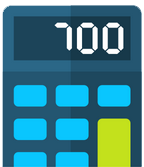Calculate Your Tool Tax Refund Easily
A tool tax refund can be secured by making a claim for capital allowances. The amount of tax relief from a capital allowances claim is generally worth 18% of the total value of your tools.
So if you bought £10,000 worth of tools a tool tax refund worth £1800 could be claimed back.
HMRC also uses the rate at which you pay tax to calculate the tool tax refund you are due.
For example, if you spent £10,000 on qualifying tools, you could claim £1800 in tax relief.
The actual money you receive depends on your tax rate – basic rate taxpayers (20%) would get £360 back (20% of £1800), while higher rate taxpayers (40%) would receive £720.
Our tool tax refund calculator can help you estimate how much you may be owed back from HMRC.
We cover below what tools can be eligible for tax relief and the best way to claim so you can maximise your refund.
What is tool tax relief?
Tool tax relief exists to help employed workers recover some of the money they have spent on tools bought for work.
The tax relief is given against the income tax you have already paid HMRC through your job.
After a successful claim HMRC refunds some of the tax you have paid as a tax rebate.
You’re eligible if you buy tools that are necessary for your job, pay for them yourself without reimbursement from your employer, and use them specifically for work purposes.
This relief is particularly relevant for tradespeople in the construction industry and mechanics, but applies to any profession where you must purchase your own equipment to perform your job duties.
Who can qualify for a tool tax refund?
The list is long but here are just some of the different types of professions that can qualify:
- Mechanics for tools and tool boxes (this includes tool boxes bought on finance).
- Joiners for all tools.
- Electricians for all tools.
- Chefs for knives.
- Hairdressers for equipment like scissors.
Many trades people have to keep buying tools on a regular basis meaning a claim can be made after the end of each tax year.
Which tools qualify for tax relief?
Tools that qualify for tax relief must be necessary for performing your job, purchased entirely at your own expense, and used primarily for work purposes.
The tools must be essential for your work – optional items that merely make your job easier but aren’t necessary don’t qualify.
Examples include:
- Hand tools (hammers, screwdrivers, wrenches).
- Power tools (drills, saws, sanders).
- Specialist equipment specific to your trade.
- Safety equipment required for your job.
Items that don’t qualify include tools provided by your employer, or equipment used primarily for personal purposes.
The key test is whether the tool is essential for you to perform your specific job duties.
Do I need receipts to claim tax relief on tools?
To claim for the actual cost of what you have spent on tools you will need to provide HMRC with evidence.
While receipts provide the strongest proof for your claim and allow you to use the capital allowances method (which often results in higher rebates), you can still make a claim without them.
If you don’t have receipts, you may be able to use the flat rate allowance system, which provides industry-specific standard amounts that HMRC accepts without requiring proof of purchase.
The difference between capital allowances and flat rate allowances for tools
Capital allowances let you claim tax relief based on the actual amount you spent on tools (typically 18% of the purchase price) and require receipts or proof of purchase.
This method often results in higher claims, especially for expensive tools.
Flat rate allowances are fixed amounts set by HMRC for specific industries (e.g., £120 for mechanics) that you can claim without detailed receipts.
While easier to claim, flat rate allowances may result in lower rebates if you’ve spent significant amounts on tools.
Your choice should depend on your spending level and available documentation.
Tax refund on your finance agreements
If you spread the cost of your tools by using a finance agreement with a tool provider we are very successful in securing a tax rebate on the interest part of your finance payments.
For example if you’re a mechanic who’s bought a tool box from MAC or Snap on all we need is the finance agreement from your tool provider to reclaim the relief you are due.
IMI tax relief
If you pay for your own membership into the Institute of the Motor Industry you will be eligible for tax relief on the membership fee.
How do I claim tax relief on tools through HMRC?
You can claim tool tax relief in three main ways:
- Online through HMRC’s website using the iForm service and Government Gateway account.
- By post using the P87 form (for claims under £2,500).
- Through Self Assessment tax return (mandatory for claims over £2,500).
For online and postal claims, you’ll need to provide details about your employer, job role, and the tools purchased. HMRC typically processes claims within 8-12 weeks, though this can vary depending on workload and the complexity of your claim.
Tool tax refund FAQ’s
Do I need my receipts? To make a tool tax refund claim for the actual cost of tools bought you will need proof of purchase. This can be in the form of an activity report from your tool provider or an individual receipt.
Do I have to be self employed? No you don’t need to be self employed to qualify. Employed people are entitled to claim tax relief on tools bought for work and it doesn’t matter if you have had different employers.
How far back can I claim? A claim can be made for the last four tax years but receipts can often still be used for as far back as you can provide them for, as long as the item is still in use and you are claiming capital allowances.
How long does a claim take? A claim for tax back on tools typically takes up to 12 weeks to complete due to tax office timescales. It can take longer if HMRC are busy or need to ask you questions about your claim.
What if I don’t have receipts? You can always ask your tool provider for copies but if this isn’t possible you can claim for a tax code tool allowance. The tool allowance is usually worth £120 per tax year and can be backdated four years. The allowance is an agreed an amount for particular trades, which can be claimed without the need for receipts.
Other Tax Rebate and Tax Refund Calculators:






